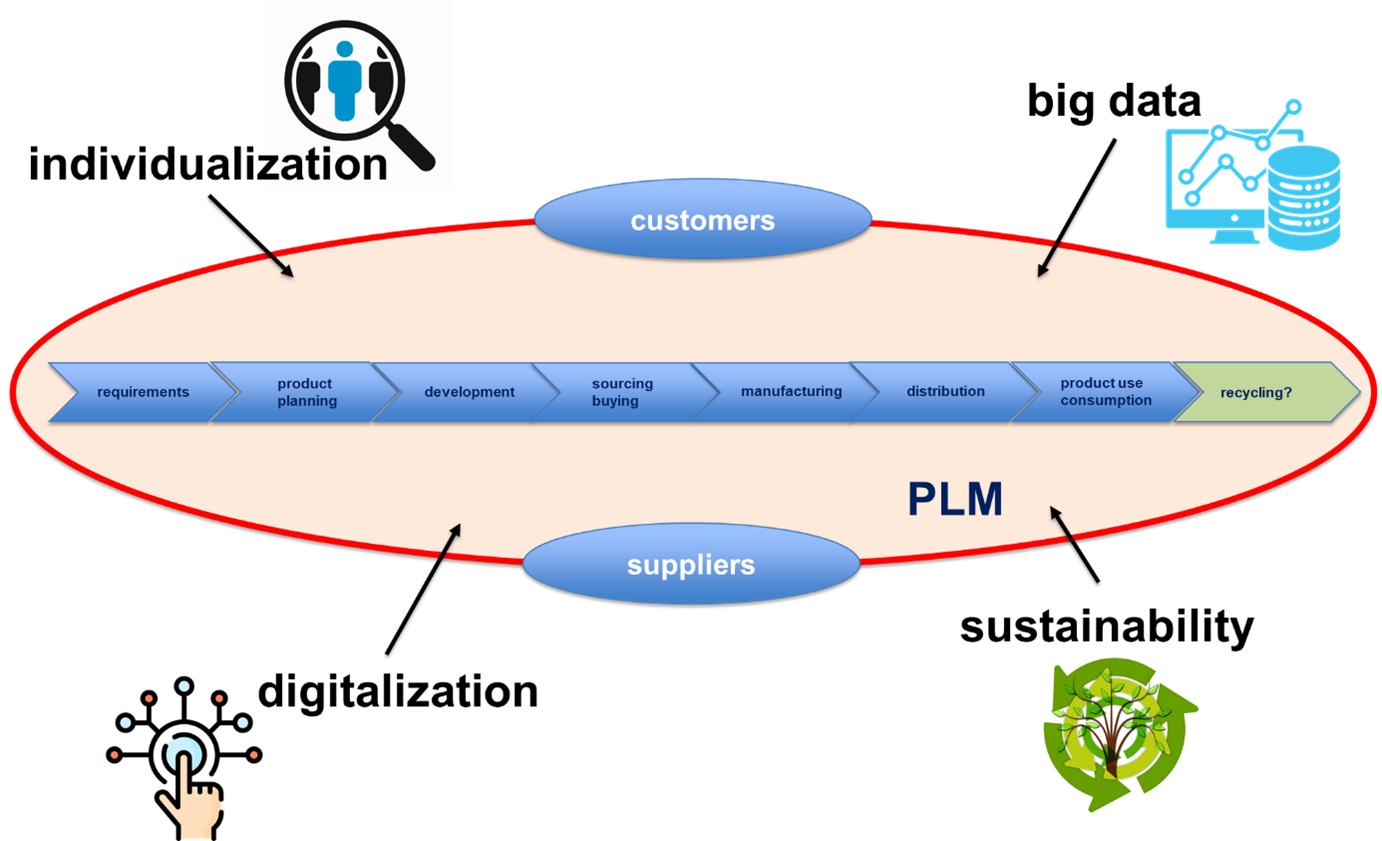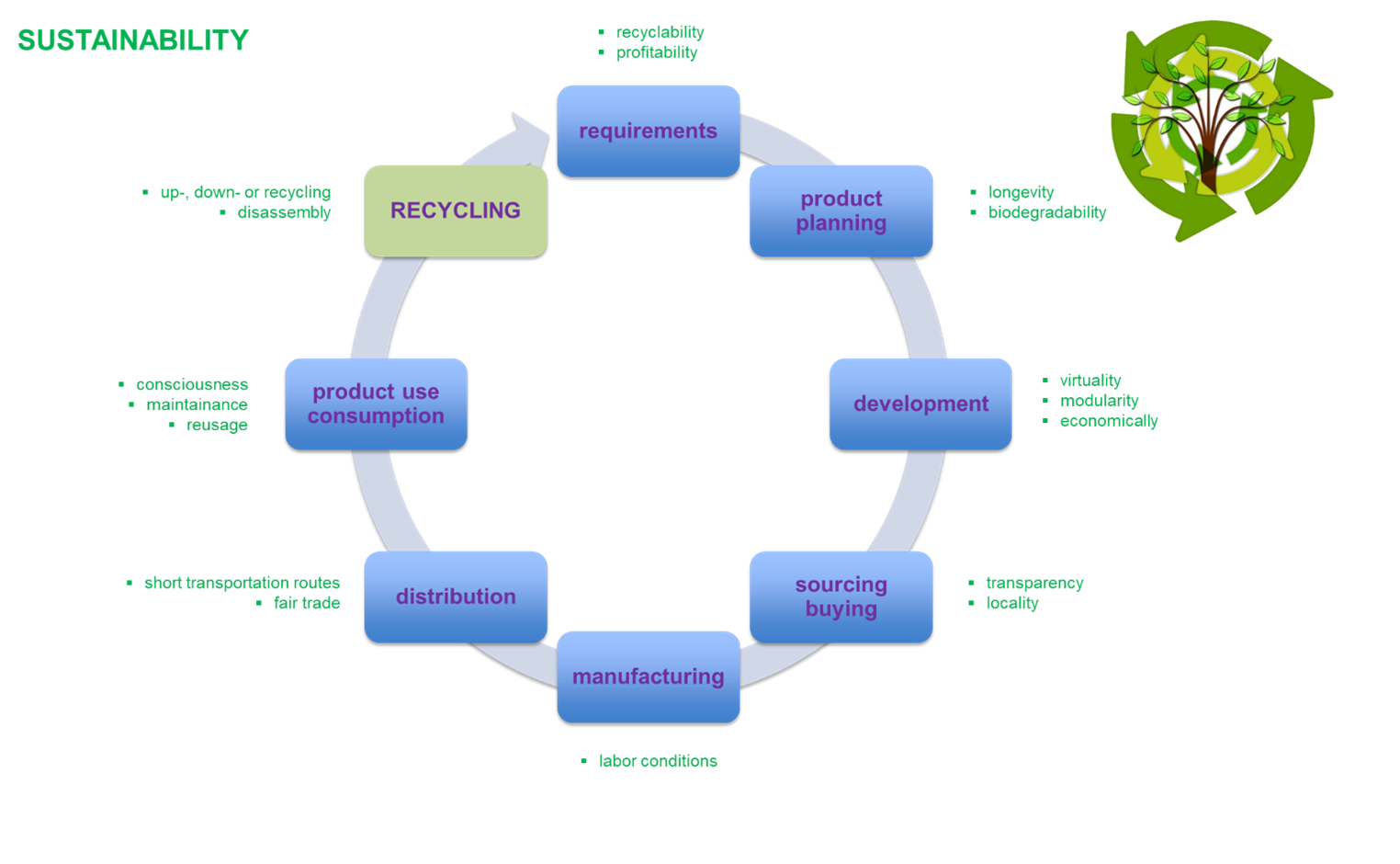Challenges for the Clothing Product Lifecycle Management
16.03.2022

A brief overview of challenges for PLM driven by Sustainability, Digitalization, Big Data and Individualization
 (Own representation based on Eigner, Martin; Stelzer, Ralph (2009): Product Lifecycle Management: Ein Leitfaden für Product Development und Lifecycle Management. 2nd Edition, Berlin, Heidelberg. Springer. p. 9)
(Own representation based on Eigner, Martin; Stelzer, Ralph (2009): Product Lifecycle Management: Ein Leitfaden für Product Development und Lifecycle Management. 2nd Edition, Berlin, Heidelberg. Springer. p. 9)
Processes of the Clothing Product Lifecycle. The Clothing Product Lifecycle and its Processes
The complex process of clothing product development usually derives from the company‘s business strategy and the markets‘ or target customers‘ requirements. Market research results and historical data are collected and translated into product requirements. So within the first process in the clothing product lifecycle all the product requirements should be identified. The next process deals with strategic product planning and the definition of the product portfolio – that is in clothing development the so called range plan. Within this process timelines are scheduled, product groups to be represented in the collection are identified and the number of items to be developed are defined. Development and production methods are appointed and requirements are translated into concepts. That process is followed by the actual product development process where – according to their specific production processes – the garments of each range are designed and constructed and depending on the method used in information processing – manufactured or simulated. Clothing product development requires iterative cycles of fitting the garments. Results of fitting modifications may have to be applied and require the manufacturing or simulation of the modified garment again. That will be followed by another fitting until the garment meets all the specified requirements. The documentation of all the design and technical information – the so-called Design Specs and Tech Packs are completed at the end of this process. The development process is followed by the sourcing and buying process. Within this process the materials required and the production capacities needed are sourced and fixed. This process can also include production planning, depending on the depth of the supply chain. Usually the sourcing and buying process is closely connected with the development process to ensure the feasibility of the production processes that follow the development. Within the manufacturing process the garments are produced or manufactured in the way that their specific production process requires. Quality Control ensures that the manufactured garments meet the requirements and specifications. In the distribution process the finished garments are then packed and allocated through different channels, depending on the business model used, until they reach their users, the consumers. During the product use – or else consumption-process - the garment is worn by the consumer. Most probably maintenance of the garment will take place by laundering or dry cleaning during this period. The use of the garment by the consumer usually ends when the consumer decides not to wear this garment any more due to several reasons – maybe the garment is worn out or destroyed or it turns out to be too large or to small – or it is just not fashionable anymore. Then it can of course be reused by another consumer – until the garment finally will be disposed of by some consumer. This usually marks the end of a products lifecycle. But there is another option because the consumption process can be followed by a recycling process and the garment can be up-, down- or recycled. According to John Stark (2020), “Product Lifecycle Management (PLM) is the activity of managing, in the most effective way, a company‘s products all the way across their lifecycles; from the very first idea for a product all the way through until it is retired and disposed of.” PLM should further manage the whole product portfolio of a company and “maximise the value of current and future products for both customers and shareholders.“ (Stark, John (2020): Product Lifecycle Management (Volume 1): 21st Century Paradigm for Product Realisation, 4th Edition, Cham, Switzerland: Springer: 1) Therefore PLM not only integrates interactions with customers and suppliers, PLM also is challenged by the four major drivers of transformation in fashion business that are to be dealt with these days:
- Sustainability
- Digitalization
- Big Data
- Individualization
 Drivers of Transformation. PLM and its Transformation Drivers. (Own representation based on Eigner, Martin; Stelzer, Ralph (2009): Product Lifecycle Management: Ein Leitfaden für Product Development und Lifecycle Management. 2nd Edition, Berlin, Heidelberg. Springer. p. 37)
Drivers of Transformation. PLM and its Transformation Drivers. (Own representation based on Eigner, Martin; Stelzer, Ralph (2009): Product Lifecycle Management: Ein Leitfaden für Product Development und Lifecycle Management. 2nd Edition, Berlin, Heidelberg. Springer. p. 37)
SUSTAINABILITY
One of the major issues concerning sustainability is circularity – Circular Fashion is one of the Buzz-Topics related to the Clothing Product Lifecycle. Therefore, the first Challenge would be turning the product life cycle into a product life circle. If we do so – the biggest challenge is the recycling part. To be able to really recycle clothing products, we have to put recyclability into our requirements and actually generate product ideas from that. But we still have to consider that our company has to survive and that means that we have to generate some kind of profitability to be able to attract shareholders. We can plan our garments, so that their lifecycles will be longer than today’s „usual“ and for example care for biodegradability when choosing materials and components of the garment. We could switch to virtual product development to save resources in prototyping and sampling. We can develop modular clothing that might be easier to disassemble. Also, we can change our development processes to work more economically. In Sourcing and Buying we are challenged to enhance transparency and move back to more locality. Besides chemical distress one of the major challenges in sustainable manufacturing is to improve labour conditions including living wages. In distribution we must limit down our transports and ensure fair trading – that of course also applies to our sourcing and buying process. The consumer is challenged to act consciously in consumption and maintenance of the garments and support reusage of clothing. The biggest challenge though will be the recycling process – in our product development we already have to consider recyclability of materials and the possibility of disassembly after usage.  PLM Challenges driven by Sustainability. Challenges of the product Lifecycle driven by Sustainability
PLM Challenges driven by Sustainability. Challenges of the product Lifecycle driven by Sustainability
DIGITALIZATION
Digitalization also challenges the management of the clothing product lifecycle. Here the major challenge is the integration of product information along the products life cycle. We need a so-called product data backbone where all the information - all the data from all the processes related to a product - is stored in a way, that from different players along the products lifecycle, the information will be simultaneously at hand to support process control and decision making. Digitalization has its impact on the requirement process that it offers opportunities in customer needs management, that of course also applies to big data… We use digital solutions for our cost management or cost reduce planning, for product data management and of course computer aided design 2D or 3D. Digitalization supports our information flow in the supply chain as well as in manufacturing through enterprise resource planning. The distribution process may be supported by supply chain management systems as well as by efficient consumer response-tools. During the usage or consumption, digitalization enables the formation of user communities and helps companies with their customer relationship management. For the recycling process we need technical product data to decide in which way the products parts / materials can be used again – especially when it comes to the use of chemicals during the products lifecycle.  PLM Challenges driven by Digitalization. Challenges of the product Lifecycle driven by Digitalization.
PLM Challenges driven by Digitalization. Challenges of the product Lifecycle driven by Digitalization.
BIG DATA
Big-data-challenges are closely linked to digitalization-challenges, but they offer a special twist: Especially in the requirement process we can benefit from collecting data that shed light on our customers cravings, needs and desires – even their preferences and their special way of decision making can be detected by algorithms. The Idea now is to use the collected data to extract product design directions in the product planning and development process – also with artificial intelligence – people are working on it… Big data can support decision making in terms of how to apply modularity and virtual product development. In supply chain management we can use blockchain technology and non-fungible tokens to reduce risks of any kind of fraud. In manufacturing big data can help to identify information and patterns which enable to improve the workflow processes. In distribution big data enables better forecasting and therefore enhanced stock control. During product use and consumption big data can analyse usage patterns and detect preferences. In recycling big data can improve accuracy in disassembling and sorting as well as enhance transparency within the global recycling supply chain.
PLM Challenges driven by Big Data. Challenges of the product Lifecycle driven by Big Data
 PLM Challenges driven by Big Data. Challenges of the product Lifecycle driven by Big Data.
PLM Challenges driven by Big Data. Challenges of the product Lifecycle driven by Big Data.
INDIVIDUALIZATION
Individualization is also a very challenging topic: To be able to realize customized products, preferably on demand, we will have to establish modular concepts which work with common parts strategies within the product planning and development processes. We must adapt our sourcing and buying process and our manufacturing process according to our common parts strategy and seek suppliers that work on just in time concepts with us. Mass customization and manufacturing on demand will help to reduce stock, our distribution channels will be closely connected with the customer requirements management. Customized products will enhance longevity in consumption by the customer that co-developed the product. Reusage though will be harder with customized products.  PLM Challenges driven by Individualization. Challenges of the product Lifecycle driven by Individualization.
PLM Challenges driven by Individualization. Challenges of the product Lifecycle driven by Individualization.
So our clothing product lifecycle is challenged within every process as shown below:
 PLM Challenges. Challenges of the product Lifecycle driven by Sustainability, Digitalization, Big Data and Individualization. Therefore, we must work on every single process of a clothing product’s lifecycle to enable circularity. To be continued…
PLM Challenges. Challenges of the product Lifecycle driven by Sustainability, Digitalization, Big Data and Individualization. Therefore, we must work on every single process of a clothing product’s lifecycle to enable circularity. To be continued… 
Britta Wiemer
Prof. Dipl.-Ing. (FH), Dipl.-Wirt.-Ing. (FH)
